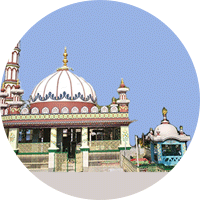Thirty-First Assembly (Khwan-Pur-Nemat)

Thirty-First Assembly (Khwan-Pur-Nemat)
Sheikh Sharfuddin Yahya Maneri
MORE BYSheikh Sharfuddin Yahya Maneri
Auhaduddin, son of the sister of the Great Master, Sheikh Najibuddin Firdausi, was present in the assembly. The prayer- caller gave the call for the afternon prayer. After the call he said: Upon hearing the blessed name of the Prophet, in all places people place their thumbs over their eyes and quote a tradition. How can this be correct? The Venerable Master replied: I have not found that tradition anywhere in the reliable and well-known collections of traditions which are available in these regions. For this reason, the theologians of these parts do not observe it. If they see anybody observing it they do not forbid him either, because it might just be that somebody has come across a genuine tradition concerning this matter, or has heard about one. At any rate, it has come down as a story. One can use that story as a proof of its genuineness provided the story itself is correct.
The story is that a command was once issued to Adam: 'We shall give birth to a son among your posterity. We, who have created 18,000 worlds, have done so out of love for that son of yours. All the qualities of a prophet have been bestowed upon Adam. Thus, it was that Adam expressed the desire of seeing that son of his. He was told: 'We have commanded him to be born at the end of time so how can you see him at the present time? We shall, however, disclose his light to you now.' Afterwards the light of the Prophet was made to shine on Adam's thumbs. Adam looked at them, kissed them and placed them on his blessed eyes.
Afterwards the Venerable Master said: If the story be true, it could provide a basis for the genuineness of this tradition.
NOTES AND REFERENCES
1. The five works-four manuscripts and one printed version-all have this form.
2. Najibuddin was Sharafuddin's own spiritual guide. For this reason, Auhaduddin was an honoured guest.
Auhaduddin, son of the sister of the Great Master, Sheikh Najibuddin Firdausi, was present in the assembly. The prayer- caller gave the call for the afternon prayer. After the call he said: Upon hearing the blessed name of the Prophet, in all places people place their thumbs over their eyes and quote a tradition. How can this be correct? The Venerable Master replied: I have not found that tradition anywhere in the reliable and well-known collections of traditions which are available in these regions. For this reason, the theologians of these parts do not observe it. If they see anybody observing it they do not forbid him either, because it might just be that somebody has come across a genuine tradition concerning this matter, or has heard about one. At any rate, it has come down as a story. One can use that story as a proof of its genuineness provided the story itself is correct.
The story is that a command was once issued to Adam: 'We shall give birth to a son among your posterity. We, who have created 18,000 worlds, have done so out of love for that son of yours. All the qualities of a prophet have been bestowed upon Adam. Thus, it was that Adam expressed the desire of seeing that son of his. He was told: 'We have commanded him to be born at the end of time so how can you see him at the present time? We shall, however, disclose his light to you now.' Afterwards the light of the Prophet was made to shine on Adam's thumbs. Adam looked at them, kissed them and placed them on his blessed eyes.
Afterwards the Venerable Master said: If the story be true, it could provide a basis for the genuineness of this tradition.
NOTES AND REFERENCES
1. The five works-four manuscripts and one printed version-all have this form.
2. Najibuddin was Sharafuddin's own spiritual guide. For this reason, Auhaduddin was an honoured guest.
Additional information available
Click on the INTERESTING button to view additional information associated with this sher.
About this sher
rare Unpublished content
This ghazal contains ashaar not published in the public domain. These are marked by a red line on the left.
